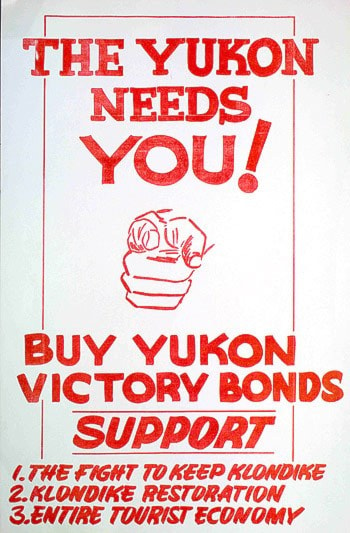It was 50 years ago this month that Edmonton city council approved spending $200,000 to set up a Klondike display at EXPO 67 in Montreal.
And that’s when all hell broke loose in the Yukon.
YUKONERS ARISE! screamed the Whitehorse Star’s biggest headline - half a page - in its 67-year history.
Edmonton had been using the Klondike theme for its annual fair in July since 1964.
But in early 1966, the Yukon legislative assembly put everything aside to focus its attention on Edmonton’s decision to use the Klondike theme at one of the biggest international exhibitions in the world.
Yukoners rallied in droves. It wasn’t long before the Klondike Defense Force was established.
Volunteers printed and sold thousands of Victory Bonds for $2 a piece to raise funds for the cause. They were even purchased from as far away as England, Germany and Australia.
Yukoners were fed up with Edmonton’s use and misuse of the theme, which had been going on for several years, former Whitehorse Star editor Flo Whyard wrote in 1986.
The Defense Force organized a rally on Main Street that brought thousands of people together. The Midnight Sun Pipe Band and entertainers such as Al Oster and Hank Karr performed live.
Former Whitehorse mayor Howard Firth and former Dawson mayor Jimmy Mellor joined the cause, as did Yukon commissioner Gordon Cameron and legislative assembly speaker George Shaw.
Shaw urged members to “stand up and fight this invasion of our rights,” Whyard wrote.
They travelled to Skagway and Haines to drum up support, while volunteers sent over 100,000 letters to households and businesses in Edmonton explaining what their officials were doing to Yukoners.
“A tidal wave of indignation swept through the Yukon as hundreds of Yukoners suddenly realized what was happening to their Klondike,” wrote Roy Minter, then the special assistant to the president of the White Pass & Yukon Route, who helped spearhead the Klondike Defense Force movement.
“The Yukon’s concern over Edmonton’s usurpation of its history goes far deeper than appears on the surface. Yukoners are intensely proud of their history and the fact that the Yukon was the scene of the most colourful gold rush the world has ever known provided them with a heritage that is second to none in Canada.”
At the time, Edmonton already called itself the Oil Capital of the World, the Heart of Alberta, Alberta’s Capital City and the Gateway to the North, Minter wrote.
“The Whitehorse Junior Chamber of Commerce suggested they should try “Edmonton, the city with a past - anybody’s past!” he added in a lengthy letter that appeared in the June/July 1966 issue of a local tourism publication.
Edmonton based its claims to the Klondike on two premises. The first was that Edmonton had been a stopping point for prospectors headed to the Yukon during the Gold Rush era.
“A few people were conned into trying this route to the Klondike during the Rush but it’s estimated that out of the 50,000 sourdoughs who came into the Klondike in ‘97 and ‘98, less than thirty made it from Edmonton - and this handful spent two years getting there,” said Shaw in 1966.
The second premise, Minter surmised, was that Edmonton felt entitled to use the Yukon’s Klondike history because, in its opinion, the Yukon was doing nothing with it.
Bea McLeod, one of the Yukon’s principal tourist promoters at the time, told Minter it would take a five-foot bookshelf to list everything the tourist industry had accomplished.
By late April 1966, Yukon’s efforts seemed to bear fruit. A delegation from Yukon’s legislative assembly visited officials at EXPO 67 and it was assured there would be no Edmonton Klondike show at the exhibition.
Edmonton officials decided to use “Old Fort Edmonton” as a theme, instead.
In 1969, then Yukon commissioner James Smith announced the territorial government had trademarked “Klondike” and that offenders would be “pursued to the fullest extent that the law permits,” according to an article in the Whitehorse Star.
But Edmonton continued using the name Klondike Days until 2006, when the fair was changed to Capital Ex.
Before the 2012 event Northlands, the non-profit running the event, announced a new name would be chosen by a public vote.
Among the six names that were available K-Days was the most popular one, returning the event to its once popular nickname.
Contact Myles Dolphin at
myles@yukon-news.com
